Madison is a beautiful town, with lovely trees providing shade, protecting our aquifer and helping to clean the air. Having more trees in the town’s “tree canopy” is a good thing. However, trees can reach the end of their natural life span, or get diseased and need to be replaced. Recently, in particular, ash trees have been lost at an alarming rate as a result of infestation by an invasive beetle. As a result, Madison needs to replenish and expand its tree population. The Rotary decided to commemorate its 100 years of community service by taking the lead on providing 100 new trees to replace and replenish Madison’s trees. Under the guidance and supervision of Madison’s Shade Tree Management Board, Rotary planned a multi-year project to plant new trees at several locations throughout the town. The trees will be planted over 3-4 years beginning in 2023.
HOW CAN YOU HELP? - Because these new trees will benefit the entire community, the Rotary is giving members of the community the opportunity to share in the project. To keep costs to a minimum, Rotary and Shade Tree Management Board members volunteer their time, and for purchasing and planting the trees we use a competitive bidding process to assure the best cost. You can help by “sponsoring” a tree for Madison with the donation of $400, which is our estimate for the costs per tree as we go forward.
For complete information, pictures of trees, locations or to help, please click READ MORE
PHASE ONE
The first phase of the project calls for a total of 52 new trees to be planted at the Lucy D Anthony athletic fields, the Madison Public Library and the Water Tower on Madison Avenue. Here are the trees set for each location in this phase:
At The Lucy D Fields
Honey Locust Honey Locust Leaves
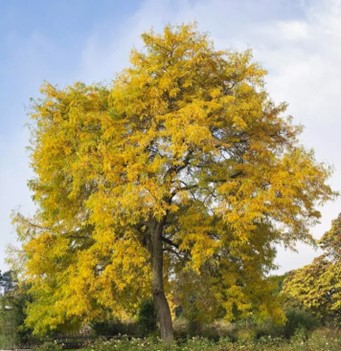
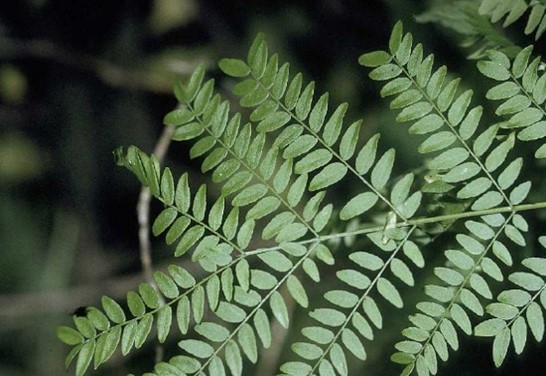
The Honey Locust (Gleditsia triacanthos) is a deciduous tree native to central North America where it is mostly found in the moist soil of river valleys. Honey locust is highly adaptable to different environments, has been introduced worldwide. The honey locust can reach a height of 65–100 ft. They exhibit fast growth, and live an average of about 120 years. The leaves are 1⁄2–1 inches and bright green. They turn yellow in the autumn. Honey locusts leaf out relatively late in spring. The strongly scented, cream-colored flowers appear in late spring, in clusters emerging from the base of the leaf.
American Yellow Wood American Yellow Wood Leaves

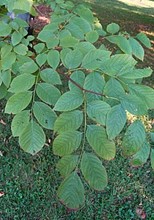
The American Yellowwood (Cladrastis kentukea) is a species native to the Southeastern United States. The Yellowwood is a small to medium-sized deciduous tree typically growing 33–49 feet tall, sometimes as tall as 89 feet, with a broad, rounded crown and smooth gray bark. The leaves are typically 8-9 inches long, with alternately arranged leaflets. In the fall, the leaves turn a mix of yellow, gold, and orange. The flowers are fragrant, white, produced in Wisteria-like stalks 10-12 inches long. White flowers bloom in early summer, and are variable from year to year, with heavy flowering every second or third year.
At Madison Public Library
Canadian Serviceberry Canadian Serviceberry Flower
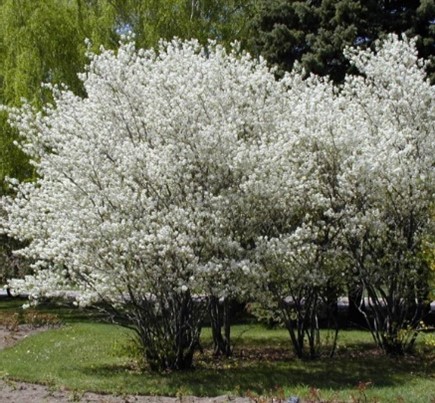
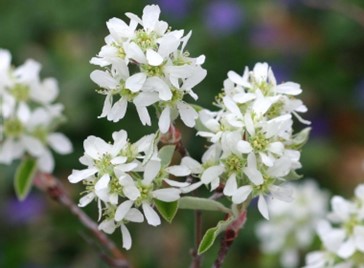
The Canadian Serviceberry (Amelanchier canadensis) is native to eastern North America in Canada and in the United States from Maine south to Alabama. It is largely restricted to wet sites, particularly on the Atlantic coastal plain. It is a deciduous shrub or small tree growing to 1½ –26 feet tall with one to many stems and a narrow crown. The leaves are simple ½ to inch in size and with a serrated edge. The flowers are produced in early spring; each flower has five white petals. Fruits, which are edible, become ripe in June and July in its native range.
Red Maple: Red Maple Leaves:
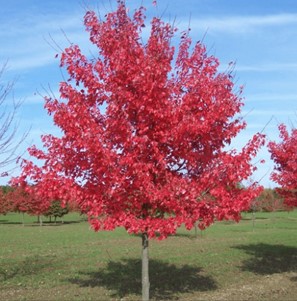
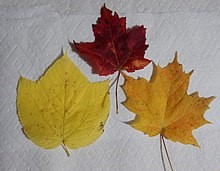
Red maple leaf in the autum, top, compared to striped maple, which turns yellow and sugar maple, which turns to orange.
The Red Maple (Acer rubrum) is one of the most common and widespread deciduous trees of eastern and central North America. The U.S. Forest Service recognizes it as the most abundant native tree in eastern North America. Over most of its range, red maple is adaptable to a very wide range of site conditions, perhaps more so than any other tree in eastern North America. It can be found growing in swamps, on poor, dry soils, and almost anywhere in between. Many of its features, especially its leaves, are quite variable in form. At maturity, it often attains a height around 100 feet. Its flowers, twigs, and seeds are all red to varying degrees. Among these features, however, it is best known for its brilliant deep scarlet foliage in autumn.
At the Water Tower (Danforth Road)
Red Oak Red Oak Leaves
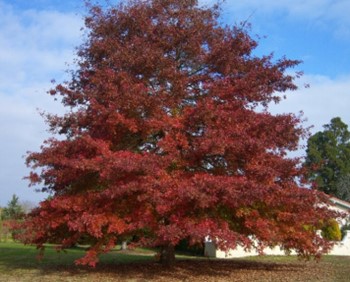
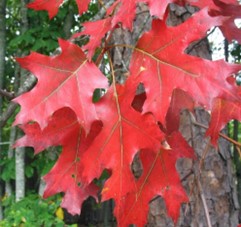
The Northern Red Oak (Quercus rubra), is a native of North America. It prefers good soil that is slightly acidic. Often simply called red oak, northern red oak is so named to distinguish it from southern red oak, also known as the Spanish oak. Northern red oak is sometimes called champion oak. In many forests, the northern red oak grows straight and tall, to 92 feet, sometimes as tall as 141 feet, with a trunk of up to 20–39 inches in diameter. Under optimal conditions and full sun, northern red oak is fast growing and a 10-year-old tree can be 16–20 feet tall. Trees may live up to 400 years; a living example of 326 years was noted in 2001. Northern red oak is easy to recognize by its bark, which features ridges that appear to have shiny stripes down the center. A few other oaks have bark with this kind of appearance in the upper tree, but the northern red oak is the only tree with the striping all the way down the trunk.
American Tulip American Tulip Leaf

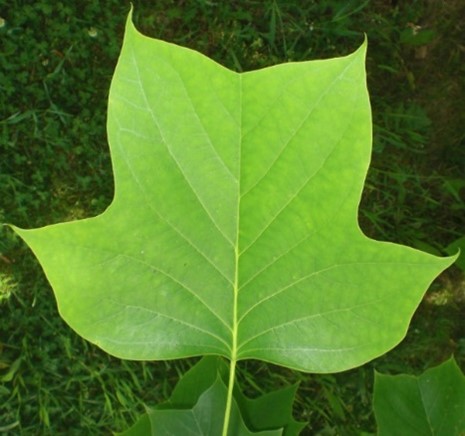
The American Tulip Tree (Liriodendron tulipifera) is the tallest eastern hardwood. It is native to eastern North America. It can grow to more than 160, often with no limbs until it reaches 80–100 feet in height, making it a very valuable timber tree. These heights are comparable to the very tallest known eastern white pines, another species often described as the tallest in eastern North America. The trunk on large examples is typically 4–6 feet in diameter, though it can grow much broader. Its ordinary height is 80–150 feet and it tends to have a pyramidal crown. It prefers deep, rich, and rather moist soil; it is common throughout the Southern United States. Growth is fairly rapid. The bark is brown, furrowed, aromatic and bitter. The wood is light yellow to brown, and the sapwood creamy white; light, soft, brittle, close, straight-grained. The tree flowers in May, with greenish yellow flowers 11⁄2–2 inches long, white turn a bright yellow in the autumn.
Southern Magnolia Southern Magnolia Flower and Foliage
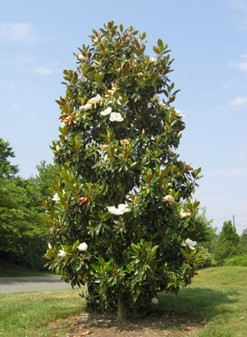
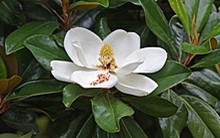
The Southern Magnolia (Magnolia grandiflora) is native to the Southeastern United States. Reaching 90 feet or more in height, it is a large, striking evergreen tree, with large, dark-green leaves up to 7 inches long and 4 inches wide, and large, white, fragrant flowers up to 12 inches in diameter. The large, showy, lemon citronella-scented flowers are white, up to 11 inches across and fragrant, with six to 12 petals with a waxy texture, emerging from the tips of twigs on mature trees in late spring. Although endemic to the evergreen lowland subtropical forests on the Gulf and South Atlantic coastal plain, the magnolia is widely cultivated in warmer areas around the world. The timber is hard and heavy, and has been used commercially to make furniture, pallets, and veneer.
PROGRESS REPORT – WHERE DOES THE PROJECT STAND?
As of November 2023, Phase One is complete! Under the guidance of the Shade Tree Management Board and with the expertise of the New Jersey Tree Foundation, all 52 trees planned in this phase have been planted. As the trees awaken in the springtime, Madison residents will begin to reap the benefits these trees will provide now and in the long-term future. Over the coming winter, Rotary will be working in plans for more trees to be planted in Phase Two during 2024.


